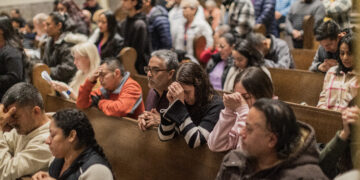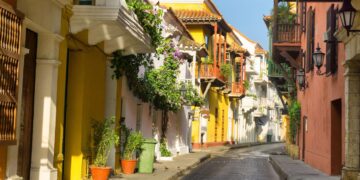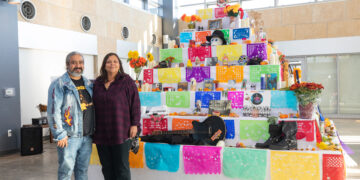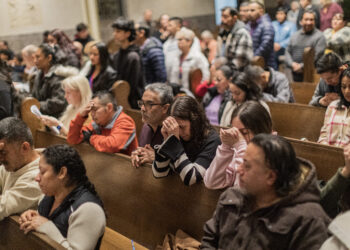On Junction Street, just north of Michigan Avenue in Southwest Detroit, sits an old brick storefront—the kind that used to be all over the city, but many have since disappeared. Garage Cultural, an arts organization that promotes social justice and community activism through art, has taken up residence in this building and has big community development plans.
Amelia Duran, CEO and arts innovator of Garage Cultural, bought the property a few years ago to save space for Southwest Detroit artists.
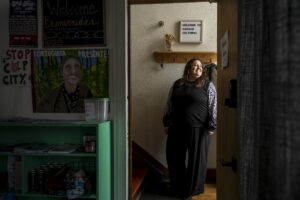
“I bought it because I was conscious of the importance of owning a building when gentrification is making space harder to access and is pushing residents out,” Duran said.
The building, a two-story storefront, comes with over an acre of land. The first floor is currently undergoing a major redevelopment with plans to open a coffee bar, a pop-up market, and retail space.
The second floor of the building will be a mix of meeting rooms and a future dwelling for artists in residence or a temporary space to call home while in transition. Garage Cultural has a homelike feel, with comfortable couches and large windows that radiate lots of natural sunlight. It will serve as a sanctuary for community organizers, artists, and musicians to express themselves freely and without limits.
Part of the expansion plan is to build a modern recording studio for Southwest’s burgeoning music scene. Local talent is getting more exposure through Southwest Fest, the annual music festival attended by media and music lovers from across the region.
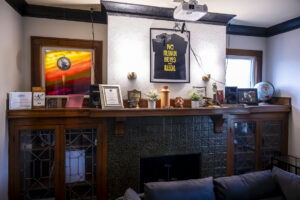
Duran was drawn to the property because it could accommodate her vision of building a state-of-the-art sound and light stage with ample seating for indoor and open-air performances.
“We’re going to build another large multifunctional space for indoor concerts, events, and panels,” Duran said. The groundbreaking for the permanent stage will be in the fall.
Garage Cultural is widely known for its murals, which have visually transformed Southwest Detroit. Through the Art on the Block (Arte en la Cuadra) Initiative, created in 2010, they have commissioned over 20 murals in the community.
In 2018, after receiving a $70,000 grant from the Knight Arts Challenge, the collective hosted a 10-day art and mural festival in Southwest Detroit, highlighting Mexican heritage and cultural connection.
This kind of art is significant, says Melissa Miranda Morse, Associate Director of the Center for Latino and Latin American Studies at Wayne State University. She examines public art from a broad perspective and explains why Latinos in the United States value murals.
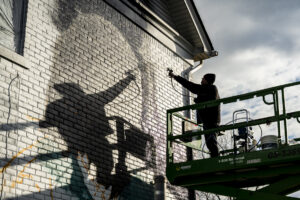
“Public art has helped to expand Latinx cultures, and seeing it was a way to be seen and to see yourself. It is also a way to brighten up and beautify spaces that might be rundown because of a lack of resources and makes art accessible.” Morse said.
“Marginalized communities don’t always get to tell their stories publicly, but public art is a way to do so,” she adds.
Most recently, Garage Cultural received the Gilbert Family Foundation “Seed and Bloom” award, a $150,000 grant over three years that supports underrepresented artists in Detroit.
Duran looks forward to continuing her work of turning Garage Cultural into a cultural epicenter in Southwest Detroit and feels proud of how far the organization has come. She credits her father, Ismael Duran, the founder of Garage Cultural and a renowned community and cultural organizer committed to social justice, with her opinions and beliefs about art.
A Chilean immigrant, Ismael Duran, immigrated during the 1970s, relocating his family to the United States. They established a new home in Detroit in the hopes of escaping political upheaval after the military coup d’état that overthrew a democratically elected socialist government. The coup ended one of the longest-standing democracies in Latin America.

“Ismael saw art as a tool by which we shape our reality,” said arts organizer Shaun Nethercott. He was game to work with anyone and understood that high arts, such as the Detroit Symphony playing at Saint Anne’s church, were as important as organizing revolutionary poetry.”
Ismael was a musician and arts instigator who focused on addressing the struggles faced by Latin Americans. He brought art and activism to Southwest Detroit, which is still the ethos of Garage Cultural, the organization he founded. Duran honors him and his memory with an ofrenda on the second floor of the new building.
Amelia Duran has been involved in community work through nonprofits since age 21. Inspired by her mother, a retired Detroit Public School art teacher, and her father, an arts revolutionary, she says taking over Garage Cultural was not a hard decision to make.
“It’s in her blood to be of service to others,” Duran often recalls her father saying.
Today, Duran is carrying the torch of Garage’s legacy, ensuring that people in the arts and cultural space have a place of belonging and a strong sense of community.
“It does feel good to be in this position now,” Duran said. “Even though it’s taken a lot of sweat equity and emotional labor.”
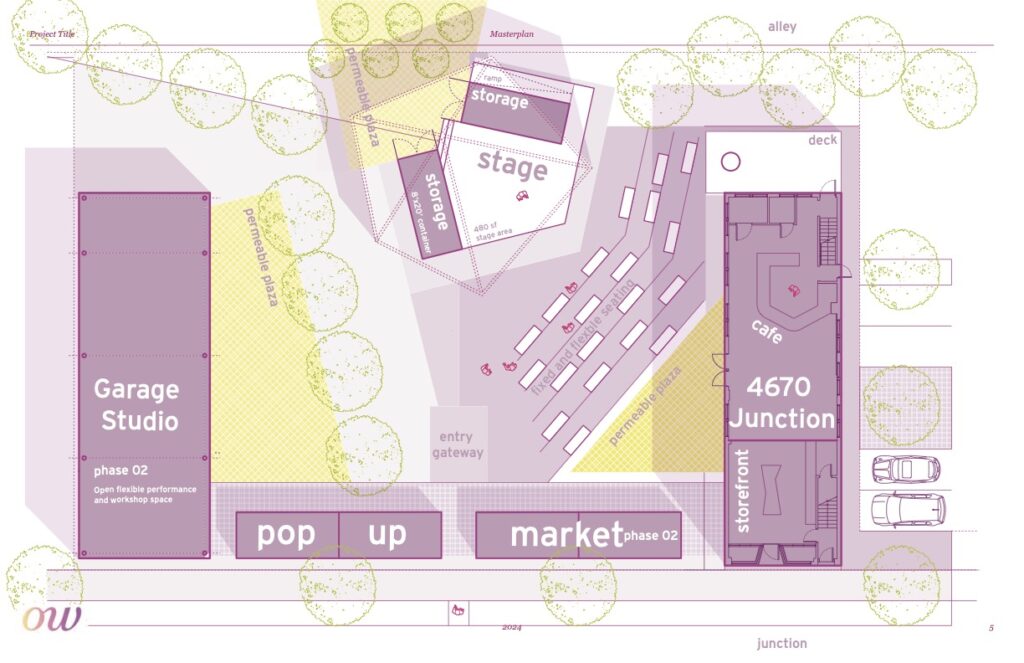
Abriendo caminos: la organización activista de arte tiene grandes planes de expansión.
En la calle Junction, al norte de la avenida Michigan, en el suroeste de Detroit, se encuentra una antigua tienda de ladrillos, de esas que solían estar por toda la ciudad, pero que han prácticamente desaparecido. El Garage Cultural, una organización artística que promueve la justicia social y el activismo comunitario a través del arte, se ha instalado en este edificio y tiene grandes planes de desarrollo comunitario.
Amelia Duran, directora ejecutiva y de innovación artística del Garage Cultural, compró la propiedad hace unos años para tener un espacio para los artistas del suroeste de Detroit.

“Lo compré porque era consciente de la importancia de ser propietario de un edificio, cuando la gentrificación hace que el acceso al espacio sea más difícil y está expulsando a los residentes”, comentó Amelia.
Es un edificio de dos pisos que cuenta con más de un acre de terreno. El primer piso se encuentra en una importante remodelación, donde se ha planificado la apertura de una cafetería, una tienda de temporada y un espacio comercial.
El segundo piso tendrá una combinación de salas de reuniones y una vivienda para artistas en residencia o un espacio temporal al que llamar hogar durante su transición. Garage Cultural tiene un ambiente hogareño, con cómodos sofás y grandes ventanales que irradian mucha luz natural. Servirá como un santuario para que organizadores comunitarios, artistas y músicos se expresen libremente y sin límites.
Parte del plan de expansión es construir un estudio de grabación moderno para la floreciente escena musical del Southwest. El talento local está obteniendo promoción a través del Southwest Fest, el festival musical anual al que asisten los medios de comunicación y amantes de la música de toda la región.

Amelia se sintió atraída por la propiedad pues se adaptaba a su visión de construir un escenario con luz y sonido de última generación, con amplios asientos para presentaciones en interiores y al aire libre.
“Construiremos otro gran espacio multifuncional bajo techo para conciertos, eventos y exposiciones” comentó Amelia. La inauguración del escenario se llevará a cabo en otoño.
Garage Cultural es ampliamente conocido por sus murales, que han transformado visualmente el suroeste de Detroit, a través de la Iniciativa Arte en la Cuadra, creada en 2010 y que han encargado más de 20 murales en la comunidad.
En 2018, después de recibir una subvención de $70,000 del Knight Arts Challenge, el colectivo organizó un festival de arte y murales de 10 días, destacando la herencia mexicana y la conexión cultural.
Este tipo de arte es significativo, expresa Melissa Miranda Morse, directora asociada del Centro de Estudios Latinos y Latinoamericanos de la Universidad de Wayne State, quien examina el arte urbano desde una perspectiva amplia y explica por qué los latinos en Estados Unidos valoran los murales.

“El arte urbano ha ayudado a expandir las culturas latinas, y verlo era una forma de ser visto y de reflejarse; también es una forma de alegrar y embellecer espacios que podrían estar deteriorados por falta de recursos y hace que el arte sea accesible. ” comentó la directora.
“Las comunidades marginadas no siempre pueden contar sus historias públicamente, pero el arte urbano es una forma de hacerlo”, añadió.
Más recientemente, Garage Cultural recibió el premio “Seed and Bloom” de la Gilbert Family Foundation, una subvención de $150.000 durante tres años, que apoya a artistas subrepresentados en Detroit.
Amelia espera continuar su trabajo de convertir el Garage Cultural en un epicentro de cultura y se siente orgullosa de lo lejos que ha llegado la organización. Ella le da el crédito a su padre, Ismael Durán, fundador de Garage Cultural y un reconocido organizador comunitario y cultural comprometido con la justicia social, por sus opiniones y creencias sobre el arte.
Un inmigrante chileno, Ismael Durán, emigró durante la década de 1970 y trasladó a su familia a los Estados Unidos. Establecieron un nuevo hogar en Detroit con la esperanza de escapar de la agitación política, después del golpe de estado militar, que derrocó a un gobierno socialista, elegido democráticamente. El golpe acabó con una de las democracias más antiguas de América Latina.

“Ismael vio el arte como una herramienta mediante la cual le damos forma a nuestra realidad”, comentó el organizador artístico Shaun Nethercott. Estaba dispuesto a trabajar con cualquiera y entendía que las bellas artes, como la Sinfónica de Detroit que tocaba en la iglesia de Santa Ana, eran tan importantes como organizar poesía revolucionaria”.
Ismael fue un músico y promotor artístico, que se centró en abordar las luchas que enfrentan los latinoamericanos. Llevó el arte y el activismo al suroeste de Detroit, que sigue siendo el espíritu del Garage Cultural, la organización que fundó. Amelia lo honra a él y a su memoria con una ofrenda en el segundo piso del edificio.
Amelia Duran ha estado involucrada en trabajo comunitario a través de organizaciones sin fines de lucro desde los 21 años. Inspirada por su madre, una maestra de arte jubilada de la Escuela Pública de Detroit, y su padre, un revolucionario de las artes, expresa que hacerse cargo del Garage Cultural no fue una decisión difícil de tomar.
“Está en su sangre estar al servicio de los demás”, recuerda Amelia que a menudo decía su padre.
Hoy, ella lleva la antorcha del legado del Garage, asegurando que Las personas en el espacio artístico y cultural tienen un lugar de pertenencia y un fuerte sentido de comunidad.
“Se siente bien estar en esta posición ahora…aunque ha requerido mucho sudor y trabajo emocional”. Comentó Amelia.
Traducción por Carmen Elena Luna











